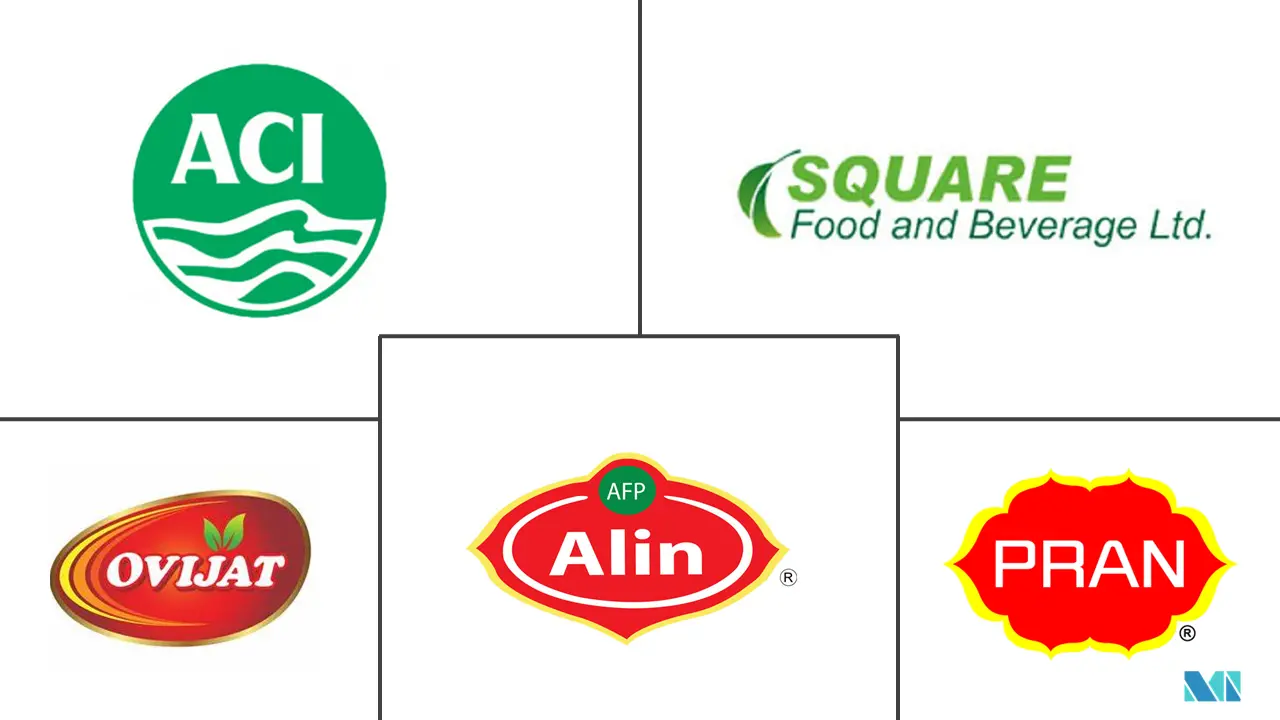Market Size of Bangladesh Rice Industry

| Study Period | 2019 - 2029 |
| Base Year For Estimation | 2023 |
| Forecast Data Period | 2024 - 2029 |
| Historical Data Period | 2019 - 2022 |
| CAGR | 4.10 % |
| Market Concentration | Low |
Major Players
*Disclaimer: Major Players sorted in no particular order |
Bangladesh Rice Market Analysis
The Bangladesh rice market is expected to register a CAGR of 4.1% during the forecast period.
- Rice is the staple food of Bangladesh's population and has a huge demand in the country. This leads to increased imports of the country from other rice-producing countries. India, China, and Pakistan are the major exporters to Bangladesh. The liberalization of import duties by the government will give a clear picture of the demand-supply gap in the country. Domestic players dominate the Bangladesh market. They are supported by strong distribution channels such as local retail stores, supermarkets, etc.
- The overall climate in Bangladesh is tropical and monsoon-type. The rice is sowed in Bangladesh in the Kharif season, starting mid-March and continuing until October. Rice is grown in the Kharif season. Due to Bangladesh's environmental conditions, rice has become a staple food in the region. Rice has many nutritional benefits.
- For instance, rice prevents obesity, provides a good amount of protein, is a good energy source, and prevents constipation. As the trend of gluten-free food is everywhere, rice is being consumed in Bangladesh in more quantity as it is gluten-free. According to United States Department of Agriculture (USDA) data from 2021, Bangladesh harvested 11,650 thousand hectares of rice in 2021. Over the medium term, demand for rice will increase in the market owing to its application in various fields, quality parameters, and convenient distribution channels.
Bangladesh Rice Industry Segmentation
Rice is a seed of Oryza Sativa, consumed as a staple food in many regions of the world. In
Bangladesh, rice is eaten as a staple food, and the market is segmented by type into regular rice and aromatic rice. Based on distribution channels, the market is segmented into supermarkets/hypermarkets, convenience stores, online channels, municipal corporation stores, and roadside shops.
For each segment, the market sizing and forecasts have been done based on value (in USD million).
| Product Type | |
| Regular | |
| Aromatic |
| Distribution Channel | |
| Roadsided Stores | |
| Municipal Corporation Markets | |
| Convenience stores | |
| Hypermarket/Supermarket | |
| Online Channel |
Bangladesh Rice Market Size Summary
The rice market in Bangladesh is a vital component of the country's economy, driven by its status as the staple food for the majority of the population. The market is characterized by a significant demand that necessitates substantial imports from countries like India, China, and Pakistan. The government's liberalization of import duties is expected to clarify the demand-supply dynamics within the country. Domestically, the market is dominated by local players who benefit from robust distribution networks, including local retail stores and supermarkets. The tropical monsoon climate of Bangladesh is conducive to rice cultivation, particularly during the Kharif season, which runs from mid-March to October. The nutritional benefits of rice, such as its role in preventing obesity and providing energy, along with its gluten-free nature, have contributed to its increased consumption. The market is also seeing a rise in demand due to the growing population and increasing disposable incomes, which are driving up rice prices.
The Bangladesh rice market is a fragmented landscape with both government and private sector involvement. The government plays a crucial role in achieving self-sufficiency through various policies and interventions, including the Public Food-Grain Distribution System, which distributes rice through both monetized and non-monetized channels. Regular rice varieties are more popular among consumers compared to aromatic types, which are preferred by the higher economic class. The market also sees the use of broken rice for animal feed, and government initiatives are supporting modern agricultural practices. Prominent market players include Alin, ACI Ltd, Pran, Square Food and Beverages, and Ovijat Foods. Recent developments, such as the introduction of new rice seed varieties and strategic import decisions, highlight the dynamic nature of the market. The focus for new entrants is to capture a share in the aromatic rice segment, while existing players continue to dominate the regular rice market.
Bangladesh Rice Market Size - Table of Contents
-
1. MARKET DYNAMICS
-
1.1 Market Drivers
-
1.2 Market Restraints
-
1.3 Porter's Five Forces Analysis
-
1.3.1 Bargaining Power of Suppliers
-
1.3.2 Bargaining Power of Consumers
-
1.3.3 Threat of New Entrants
-
1.3.4 Threat of Substitute Products
-
1.3.5 Degree of Competition
-
-
-
2. MARKET SEGMENTATION
-
2.1 Product Type
-
2.1.1 Regular
-
2.1.2 Aromatic
-
-
2.2 Distribution Channel
-
2.2.1 Roadsided Stores
-
2.2.2 Municipal Corporation Markets
-
2.2.3 Convenience stores
-
2.2.4 Hypermarket/Supermarket
-
2.2.5 Online Channel
-
-
Bangladesh Rice Market Size FAQs
What is the current Bangladesh Rice Market size?
The Bangladesh Rice Market is projected to register a CAGR of 4.10% during the forecast period (2024-2029)
Who are the key players in Bangladesh Rice Market?
Alin Foods, ACI, Pran Foods, Square Foods and Beverages and Ovijat Foods are the major companies operating in the Bangladesh Rice Market.

